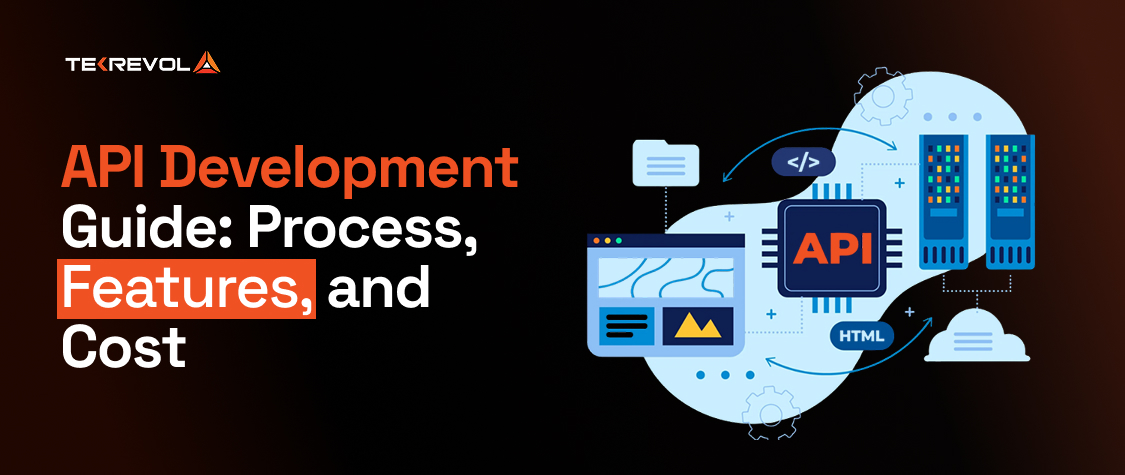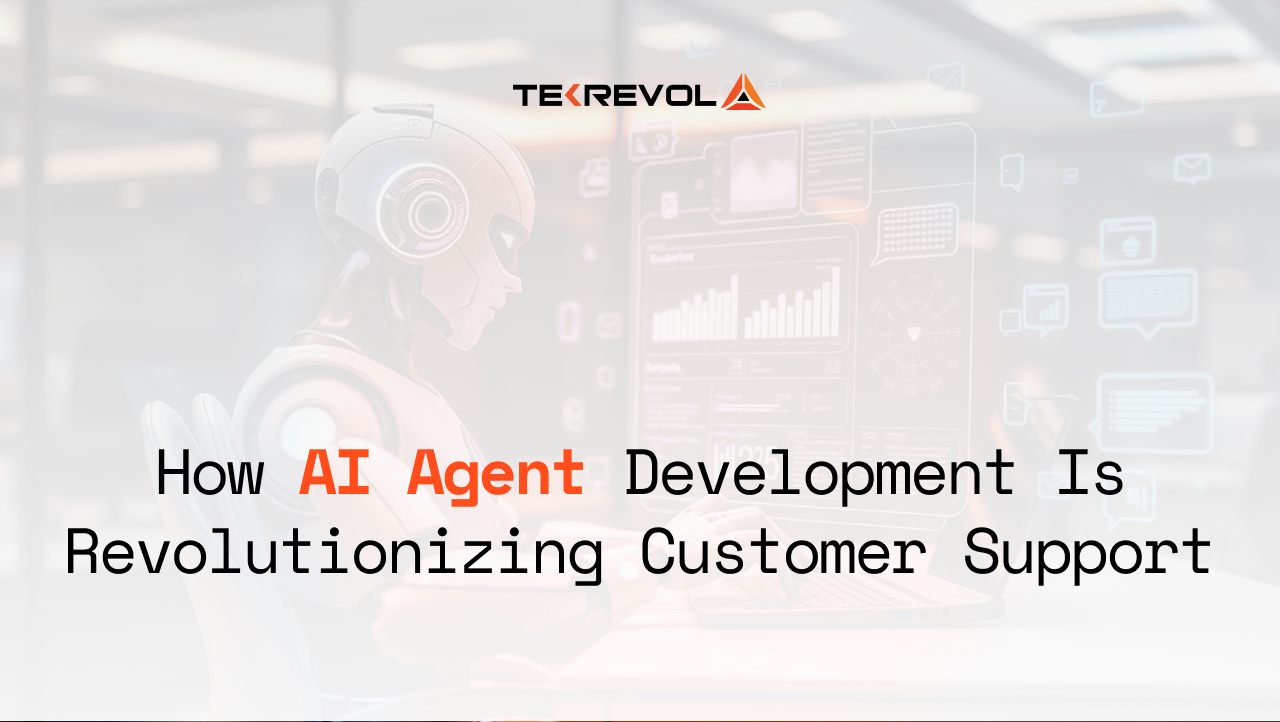You tap “Order Now” on your food delivery app. With a few taps, restaurants with live availability appear, your payment is confirmed instantly, and your meal is already on its way. What just happened? Dozens of separate systems communicated faster than you could blink.
This isn’t magic. It’s APIs.
What feels seamless to users is often complex behind the curtain. Product managers face delays, executives worry about costs, and developers tackle integration headaches daily.
From apps to SaaS to digital transformations, the challenge is the same: making systems connect seamlessly. In API development, the real complexity isn’t just coding, it’s decision-making.
Should you invest in custom-built integrations or take advantage of existing solutions? The truth is, the gap between a $5,000 integration and a $50,000 integration often comes down to complexity, & security needs. Knowing which path aligns with your goals helps prevent unnecessary costs.
In this blog, we explore the process of developing an API, its key features, costs, and best practices.
What is an API and How Does It Work?
Application Programming Interface, API, is a type of bridge that enables communication between two applications without any problems. Rather than building each feature separately, APIs enable businesses to combine existing tools that have been proven to work to create more powerful and efficient apps.
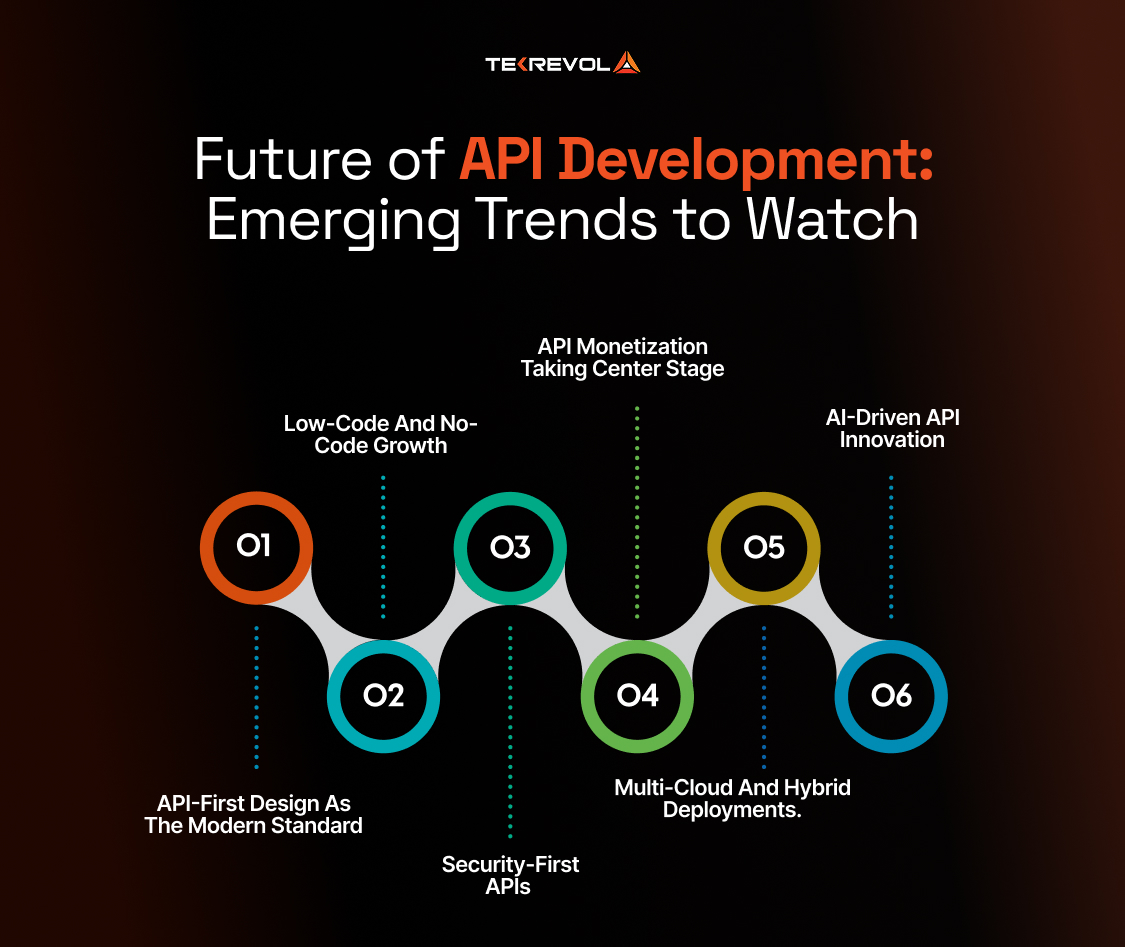
The APIs are developed based on three key elements:
- Procedures: An API’s functions describe what it can do—for example, allowing one application to integrate with another for a smoother user experience.
- Protocols: These are the rules or format that determine how information is passed between two applications. The two applications must also be able to communicate in a way that they speak the same language.
- API Development Tools: These are the components that the developers take to make or assemble APIs into applications.
So, how does an API really work behind the scenes? Let’s break it down step by step in the simplest way possible.
- Application: The application that must transfer information out or in. This is where things are taking place and information is being received or sent.
- Programming: The reason why the connection is possible. Rather than creating long, lengthy lines of code, the code of an API offers a hierarchical manner of managing the system-to-system communication.
- Interface: The contact between two applications. It helps to make sure that requests are comprehended and responses provided appropriately.
Together, these three aspects transform an API into a trusted layer that keeps data flowing and applications running effectively. This is why developing an API with precision is important for building secure and future-ready solutions.
90% of Apps Today Rely on APIs
We help you develop robust APIs that empower teams, scale operations, and deliver lasting competitive advantage for your business.
Schedule A Free Consultation Now!API Development Terminologies Every Developer Should Know
Some terminology appears often throughout API development. Getting to know them helps one confidently manage projects and grasp ideas. Here then are the major terms you need to understand.
| API Development Terminology | Definition | Usage / Importance |
| API key | Unique code used to identify and authenticate a requester. | Ensures secure access by validating who is making the API call. |
| End Point | A specific URL or location where an API receives requests and sends back responses. | Acts as the communication gateway between different systems. |
| JSON | Lightweight format for sending/receiving data. | Widely used for data exchange because it’s simple, fast, and easy to parse. |
| GET | HTTP method to retrieve resources. | Commonly used for fetching information without altering the system. |
| POST | HTTP method to send or create resources. | Essential for submitting data like forms, orders, or new records. |
| OAuth | Authorization framework for secure access. | Improves security by enabling safe authentication for third-party apps. |
| REST | Architectural style for APIs. | Powers most modern web APIs due to its simplicity and flexibility. |
| SOAP | Protocol for structured data exchange. | Used in enterprise systems that require strict standards and high security. |
| Latency | Time between request and response. | A key performance metric—lower latency means faster, smoother apps. |
| Rate Limiting | Restricts the number of API calls per user. | Prevents misuse, protects servers, and ensures fair usage. |
| API Throttling | Controls request volume over time. | Helps manage traffic spikes, improve stability, and avoid overload. |
The Major API Types and Their Uses
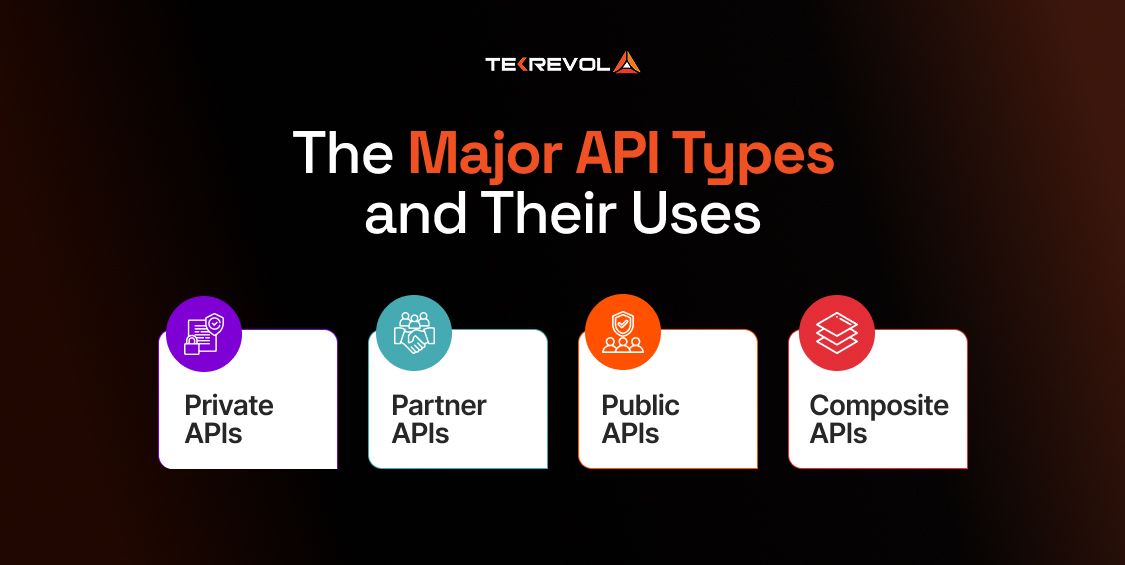
Before you dive into API integration and development, it’s worth knowing the four main types and where each shines.
-
Private APIs
Private APIs have been created just for internal usage. Through private APIs, you can manage data and link your tools, all within the safe boundaries of a corporate ecosystem. All such applications are internal by nature; hence, businesses have full control, and they are personalized exactly the way organizations want them.
Use case: Best for a business that requires much tighter integration between internal tools.
-
Public APIs
Public APIs are open to anyone who wants to use them. Mostly created for external developers to create new applications or new features, and even to experiment with combinations. These APIs give most businesses a potent avenue to increase their reach and develop new opportunities without developing everything themselves.
Use case: Best for companies able to build ecosystems, drawing in development communities, or generating new revenue streams by means of API monetization.
-
Partner APIs
Partner APIs sit right in the middle. They are not completely open to the public, but are shared with selected partners you trust. It makes them perfect for collaboration as they enable two organizations to work together and share data without losing control over security.
Use case: Perfect for B2B collaborations where controlled access, trust, and data security are equally important.
-
Composite APIs
Composite APIs aim at simplifying the tasks of developers. You don’t need to make multiple requests in different places; everything you need can be accessed at once. This implies quicker execution, fewer and an overall much less painful experience among developers and users.
Use case: A great fit for complex systems like mobile apps or dashboards where speed and performance directly impact the user experience.
API Development Tools and Technologies Behind High-Performing APIs
API development and design rely on a wide range of tools and technologies. Before we get into API development, it’s helpful to review some of the most widely used APIs and tools in the industry.
| Tool Name | Type/Category | Description |
| Apigee | API Management Platform | Google’s API management tool for digital transformation and API integration. |
| APIMatic & API Transformer | Development Tools | Automate the generation of SDKs and code snippets. |
| API Science | Performance Tool | Evaluates the performance of both internal and external APIs. |
| Serverless Architecture | Infrastructure | Cloud-based infrastructure for designing, building, and hosting APIs. |
| API-Platform | Development Framework | Open-source PHP framework for web API development. |
| Auth0 | Authentication | Widely used tool for authenticating and authorizing APIs. |
| ClearBlade | IoT API Management | API management provider specializing in IoT technology integration. |
| GitHub | Code Repository | Open-source Git hosting for version control and collaborative development. |
| Postman | API Toolchain | Comprehensive platform for testing, documenting, and evaluating APIs. |
| Swagger | Open-Source Framework | API development framework used by major tech companies. |
| Kong | API Gateway | High-performance traffic handling with security and monitoring features. |
| RapidAPI | API Marketplace | A platform to discover, connect, and manage thousands of APIs. |
| AWS API Gateway | Cloud API Service | AWS managed service for building, deploying, and managing APIs at scale. |
The Non-Negotiable Features of Modern API Development
An API isn’t successful simply because it links two systems. The best APIs are secure, efficient, and scalable to adapt to business growth. Below are the most critical characteristics an API should have:
- Modification Timestamps: It is important to track the time the data is being created or modified so that there is no confusion, including with multiple systems.
- Paging: Massive amounts of data may cause slowness. Paging breaks information down into small fragments, enhancing response time and user experience.
- Sorting: A simple API should also provide an easy way to sort and filter data in a number of ways so that developers can be able to get exactly what they want.
- Rapidity and Accessibility: API should be rapid and accessible on demand. Delays or downtimes can cause disruption of applications and annoy the users.
- Scalability: Data increases with business expansion. An API that has been designed well should be capable of supporting growing loads without compromising performance.
- Authentication & Authorization: There should be no compromise on security. APIs should also make sure that sensitive data can only be accessed by verified applications and users.
- Caching: Caching is the temporary storage of common data, which eases server burden and accelerates server response.
- Rate Limiting: To ensure abuse does not occur, the API should limit the number of requests that an individual can make within a specific period. This guarantees fair usage and security of system stability.
- Versioning of APIs: The versioning allows new updates to be made without hindering the previous integrations, so old systems are still in use.
- Comprehensive Documentation: No API can be good without good documentation. The developers can use the clarity, updated, and easy-to-follow guides to integrate faster and make fewer mistakes.
- Logging and Monitoring: The API must always keep an eye on its operations and failures in order to be efficient and safe. Proper logging will make the issues resolved faster, and the experience of end users is going to be smoother.
API Development Process: From Idea to Launch in 8 Steps
Developing an API may appear to be a technical task, yet we have simplified the process into easy and manageable steps.
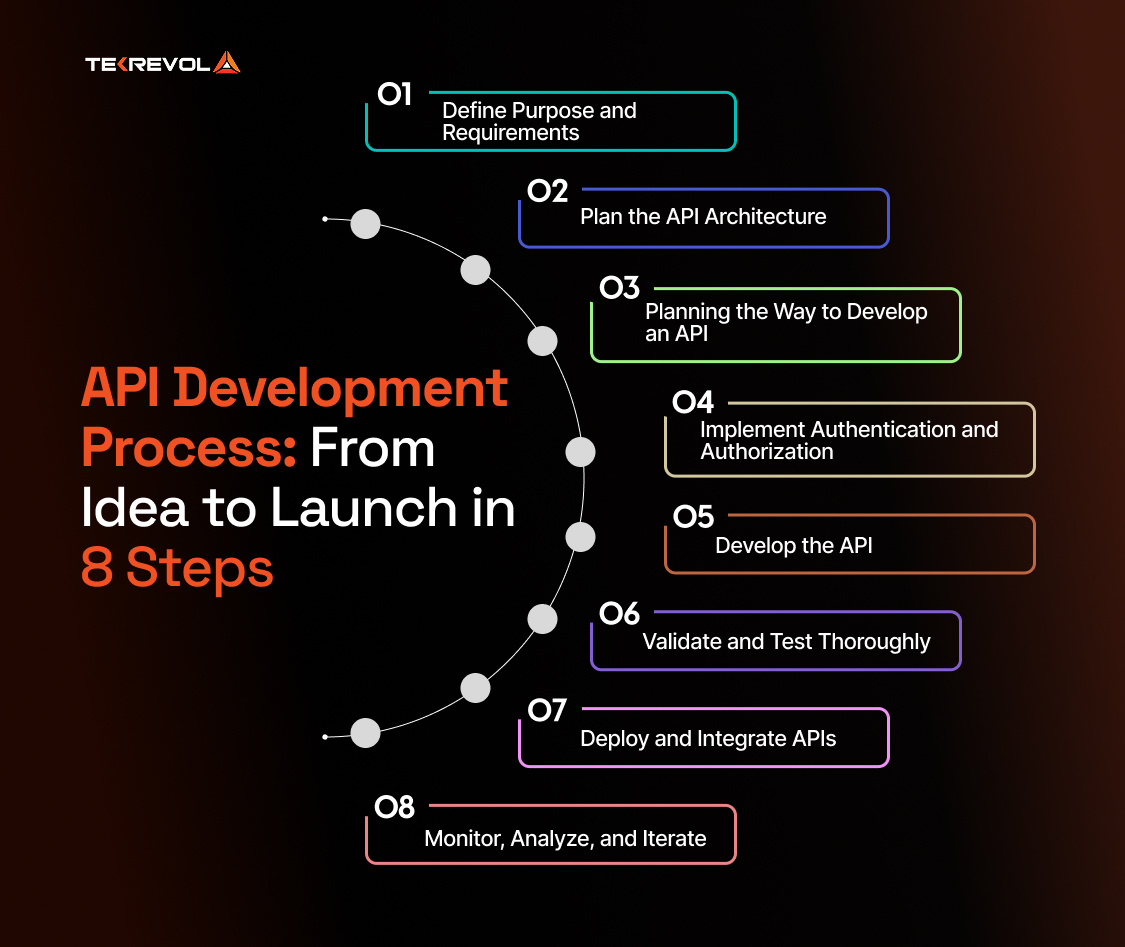
Step 1: Define Purpose and Requirements
Prior to developing an API, it is wise to understand the causes for the existence of an API as well as the problems it solves. Well-defined standards direct the design, development, and testing stages.
Key Points:
- Determine who will be interested in the product.
- Establish API objectives and goals.
- Point out features and functionality required.
- Establish performance expectations and scale expectations.
Step 2: Plan the API Architecture
Choose API type (REST, SOAP, GraphQL) and define how it is going to interact with the clients and servers. With proper planning, your API will be scalable and secure.
Key Points:
- Decide on the architecture type and the communication protocol.
- Planning routes, destinations, and resources.
- Specify data formats and formats of response.
- Think of authentication and error-handling procedures.
Step 3: Planning the Way to Develop an API
Choose a viable direction and tooling approach to best meet the purpose of your project. Your decisions at this time can affect API performance, security, and scaling.
Key points:
- Choose the most appropriate method of constructing and organizing your API.
- Prepare data management, access, and storage.
- Take into account the place where the API will be operated and its scaling.
- Prepare in advance in terms of upgrades and integrations.
Step 4: Develop the API
Proper documentation is important; it not only helps developers understand and use your API effectively but also reduces support overhead and accelerates adoption.
Key Points:
- Include endpoint descriptions, requests, and responses.
- Explain authentication methods and error codes
- Provide usage examples and best practices
- Keep documentation updated as the API evolves
Step 5: Implement Authentication and Authorization
In order to guarantee the security of personal data, access control, and user trust, it is essential to protect your API. There will be proper authentication and authorization that will ensure that only the right users and applications will interact with your API.
Key Points:
- Use authentication methods like API keys, OAuth, or JWT
- Implement role-based access controls if necessary
- Ensure HTTPS for encrypted communication
- Set up rate limiting and throttling to prevent misuse
Step 6: Validate and Test Thoroughly
This testing is necessary to ensure that your API can be deployed in any conditions. Massive testing helps in finding performance bottlenecks, security risks, edge-case failures, etc, before they are experienced by your users.
Key Points:
- Unit, integration, and load testing.
- Ecosystem Endpoints and errors: Validate all endpoints and errors.
- Test high-traffic and edge cases.
- Find solutions to problems in time.
Step 7: Deploy and Integrate APIs
Deployment is the part in which your API passes through live and begins to interact with the rest of the systems. A professional API integration services provider makes sure your deployment is seamless, allowing your API to interact efficiently with internal and external systems.
Key Points:
- Deploy on reliable cloud or hosting solutions
- Connect with internal systems or third-party services.
- Establish logging, monitoring, and alerting applications.
- Facilitate a seamless implementation with the minimum amount of downtime.
Step 8: Monitor, Analyze, and Iterate
To make sure that your API is operating efficiently, meeting the requirements of your users, it is essential to constantly monitor and enhance your API. Based on this behavior and researching the usage patterns, you will be able to find the optimization opportunities and ensure long-term reliability.
Key Points:
- Track the performance, usage, and real-time errors.
- Assess the logs and metrics with the aim of identifying the bottlenecks or inefficiencies.
- Adjust and enhance systems as per the feedback and the evolving needs.
- Assure the security and compliance of data and users.
API-Driven Businesses Grow 3x Faster
Partner with us to build AI-enhanced APIs that optimize workflows, predict trends, and ensure scalability for your business.
Talk to Our API Experts!API Development Strategies: Best Practices for Security and Scalability
APIs enable transformation, but developing an API requires strategy, security, and performance optimization. Here are the key best practices for effective API development.
| Best Practice | Description | Implementation Tips |
| Implement Throttling for Traffic Control | Throttling limits the number of requests to your API, preventing DoS attacks. | Set request limits per user or IP and define backoff strategies |
| Use an API Gateway as a Security Enforcer | Protects your API by validating and encrypting requests. | Use OAuth2, API keys, or JWT tokens to validate requests efficiently. |
| Leverage HTTP Method Overrides | Supports client actions despite restricted HTTP methods. | Implement custom headers like X-HTTP-Method-Override where needed. |
| Monitor and Assess Infrastructure | Tracks system resources to detect bottlenecks quickly. | Use monitoring tools like Prometheus, Grafana, or Datadog. |
| Prioritize Security in API Design | Ensure security at all levels, from architecture to data transfer. | Apply encryption, input checks, and safe coding standards. |
| Provide Clear Documentation for Developers | Detailed documentation makes integration easier for third-party developers. | Include examples, error codes, and step-by-step integration guides. |
| Prioritize Automated Testing | Ensures reliability, bug-free functionality, and high performance. | Use tools like Postman, JUnit, or Selenium to automate tests. |
| Optimize Performance Continuously | Improve queries, code, and caching to handle growth. | Detect performance bottlenecks through caching, load balancing, and profiling. |
Common API Development Challenges and How to Overcome Them
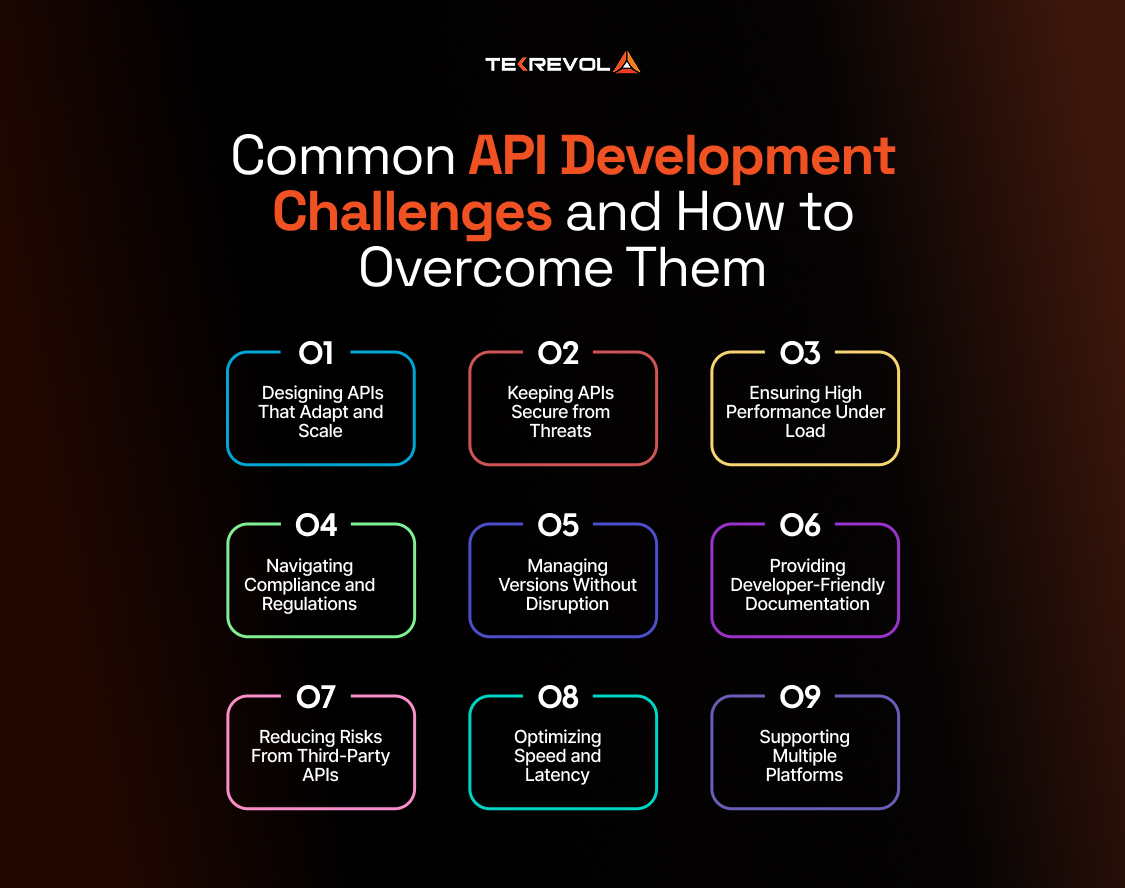
API Development is crucial to businesses; however, there are challenges associated with the process. Therefore, we have enumerated the most prevalent challenges, as well as effective solutions to assist you in creating scalable APIs.
1. Designing APIs That Adapt and Scale
One of the issues associated with APIs is the tendency to be flexible and not to sacrifice uniformity.
Impact: Irregular endpoints baffle developers and slow down integration.
Solution: adhere to a design-first strategy, enforce a more stringent naming policy, and maintain strict governance policies. This makes APIs structured and still flexible to adapt to business requirements.
2. Keeping APIs Secure from Threats
API is a common target of cyber attacks.
Impact: Credibility and trust could be damaged by unauthorized access and loss of sensitive data.
Solution: Implement OAuth 2.0, token authentication, encryption, and access control. Your API environment will be secure thanks to regular audits and penetration tests.
3. Ensuring High Performance Under Load
A maximum of traffic might overwhelm APIs, therefore delaying their response.
Impact: Users are annoyed by sluggish performance, which can result in a decline in income.
Solution: Scalable Backend infrastructure, throttle control, and caching. From the very beginning, the construction was designed to accommodate large traffic so that it operates smoothly throughout.
4. Navigating Compliance and Regulations
Working with sensitive data means following norms such as PCI DSS, HIPAA, or GDPR.
Impact: Non-compliance may expose to fines and reputation damage.
Solution: Include audit logs, secure data processing, and compliance testing in the API development process to remain compliant with regulations.
5. Managing Versions Without Disruption
The APIs require updating, and the alterations may destroy the already existing integrations.
Impact: Clients can be exposed to downtime or errors.
Solution: Introduce the strict versioning rules, backward compatibility, and gradual depreciation to provide smooth transitions.
6. Providing Developer-Friendly Documentation
The inadequate documentation delays the adoption and introduces integration errors.
Impact: More support requests and slow time-to-market.
Solution: Design interactive and dynamic documentation using Swagger/OpenAPI to have an easy developer experience.
7. Reducing Risks From Third-Party APIs
External dependencies may break down at any time without notice.
Impact: Outages or bad service will impact your API reliability.
Solution: Fallback mechanisms, real-time monitoring, and periodic assessment should be implemented to alleviate risks associated with third-party services.
8. Optimizing Speed and Latency
The delay of APIs annoys users and negatively affects interaction.
Impact: Reduced satisfaction and possible decrease in usage.
Solution: Use optimal query parameters in the database, trim down payload, cache, and CDN to provide low-latency and high-speed responses.
9. Supporting Multiple Platforms
APIs must be compatible with web, mobile, and IoT environments.
Impact: Platform-based problems make development more complex.
Solution: Cross-platform compatibility at the design level so that it will be easier to integrate and ensure uniformity across gadgets.
How Much Does it Cost to Build an API for Web and Mobile Apps?
Estimated Cost: $5,000 – $100,000+
The API development cost may differ according to complexity, functionality, and security. The following is a realistic roadmap to help you understand the pricing and timeline.
| API Complexity | Estimated Cost | Estimated Time to Develop |
| Basic API | $5,000 – $15,000 | 2–4 weeks |
| Moderate API | $15,000 – $50,000 | 1–3 months |
| Complex API | $50,000 – $100,000+ | 3–6+ months |
See Your API Costs Clearly Before You Start
Submit your project info and get a personalized estimate from our experts, helping you plan with confidence.
Get A Quote!API Business Models for Profit and Growth
APIs are not simply technical solutions anymore; they are now business assets. Business organizations are using APIs today as a strategy to generate new sources of revenue and improve operational processes.
The following are the best API monetization strategies described:
| Strategy | Description | Best For |
| Usage-Based Pricing | Charge users based on API calls, data, or transactions. | Services with variable usage, like payments or location APIs |
| Freemium Access | Offer basic features for free, and premium features for paid plans. | SaaS platforms or apps aiming for fast adoption |
| Revenue Sharing | Partner APIs with a share of revenue from third-party usage. | Payment, logistics, or partner-integrated services |
Future of API Development: Emerging Trends to Watch
In modern API development, they have become the backbone of digital platforms, not just connectors. As companies manage thousands of APIs, future trends point toward intelligent automation and enhanced security. Here are the trends shaping what’s next:

1. API-First Design as the Modern Standard
APIs now serve as the essential foundation for digital products. 74% of developers adopted an API-first approach in 2024, up from 66% in 2023, emphasizing the prioritization of APIs in modern software architecture.
Those implementing this approach focus on designing early, documenting consistently, and ensuring cross-platform support for systems that are both scalable and adaptable.
2. Low-Code and No-Code Growth
The introduction of low-code and no-code development tools is changing development. The platforms accelerate API development, as well as allowing non-technical groups to provide input without compromising agility.
3. Security-First APIs
Since APIs deal with sensitive data, effective security is of paramount importance. OAuth 2.0, encrypted communication, use of tokens to gain access, and real-time monitoring are becoming the norm. Companies that are grounded in security will win their confidence and competitive power.
4. API Monetization Taking Center Stage
APIs are regarded more as sources of revenue, and not merely connectors. Businesses are trying out concepts such as freemium access, user-based pricing, and partner monetization in order to access new potential growth.
5. Multi-Cloud and Hybrid Deployments.
Businesses are shifting towards multi-cloud. APIs should blend and adapt successfully in both the public clouds, the internal infrastructure, and the on-premise systems, providing flexibility and robustness in a variety of settings.
6. AI-Driven API Innovation
AI is redefining APIs that have machine learning, natural language processing, and predictive analytics. These smart APIs allow making decisions faster and provide personalized customer experiences at scale.
Partner with TekRevol for AI-Powered API Development & Integration
Every groundbreaking product begins with one question: “Will this idea work?” At TekRevol, we can assist you in answering it: fast, effectively, and with no doubts.
Before diving into full-fledged API development, we build MVPs with tomorrow in mind. Being a reputable custom MVP development company, we use API-first designs and scalable cloud infrastructures to ensure your MVP can grow into a full-scale platform as traction builds.
At TekRevol, API development meets innovation. Whether your project is simple or enterprise-grade, our RevAI framework combines human ingenuity with artificial intelligence to deliver solutions that are intelligent, flexible, and built to last.
Why partner with us?
- Strategic Focus: We build and design what is only proven and captivates the early adopters.
- Human-Directed, AI-Assisted: We structure our RevAI framework, which means we apply human creativity and AI-informed insights to come up with smarter prototyping, predicting user behavior, and making decisions.
- Scalable by Design: Each of our MVPs is created using a solid API-first architecture that can support growth as your user base and functionality increase.
- Speed to Market: Launch in weeks, not months. Test fast, learn faster, and iterate based on real feedback.
Power Your Digital Ecosystem with Intelligent APIs
We blend human expertise and AI innovation to build secure, scalable APIs that connect, automate, and elevate your entire business.
Get a Free Consultation!